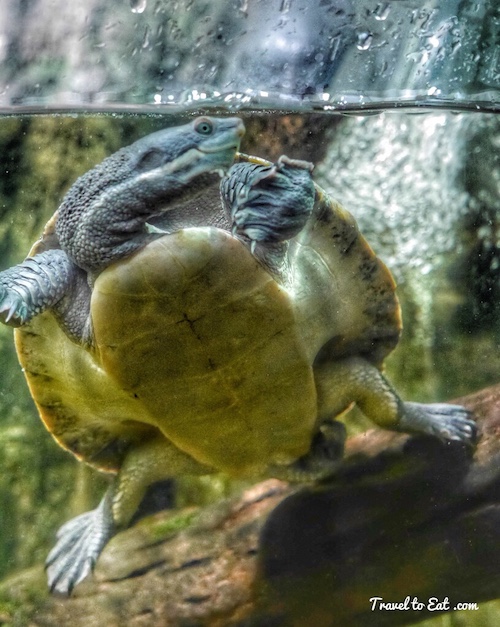
Since we were in Australia and surrounded by water we decided to visit the Sea Life Sydney Aquarium. The aquarium contains a large variety of Australian aquatic life, displaying more than 700 species comprising more than 13,000 individual fish and other sea and water creatures from most of Australia’s water habitats. Additionally, the aquarium features 14 themed zones including a Bay of Rays, Discovery Rockpool, Shark Walk, and the world’s largest Great Barrier Reef display. The aquarium was designed by Australian architects to resemble a large wave, to complement the underwater theme of an aquarium and the maritime theme of Darling Harbour, and took nearly two years to build. The Great Barrier Reef complex which opened in October 1998 continues this same theme. The Sydney Aquarium was opened in 1988, during Australia’s bicentenary celebrations, and is one of the largest aquariums in the world. I plan to separate the visit into several posts.
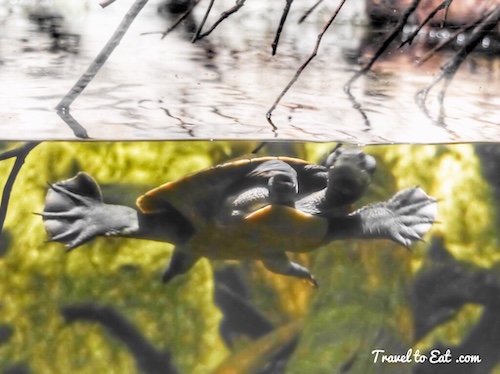

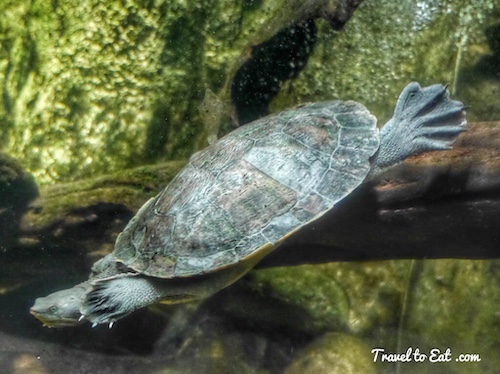
The Broad-Shelled Turtle (Chelodina expansa) inhabits large slow-moving or still bodies of water in south-eastern Australia, from southern Queensland to eastern South Australia. They have an extraordinary ability to extract oxygen from fresh water by pumping it through veined cavities in the throat and vent enabling them to remain submerged for extended periods of time. The shell is usually dark grey-brown in color, as is the upper part of the head and neck, while the throat is pale grey or creamy in color. Chelodina is an ancient group of Chelid turtles native to Australia, New Guinea, the Indonesian Rote Island, and East Timor. The turtles within this subgenus are small to medium sized, with oval shaped carapace. They are side-necked turtles, meaning they tuck their head partially around the side of their body when threatened instead of directly backwards.
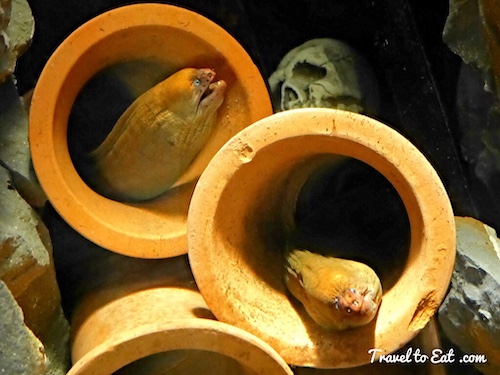
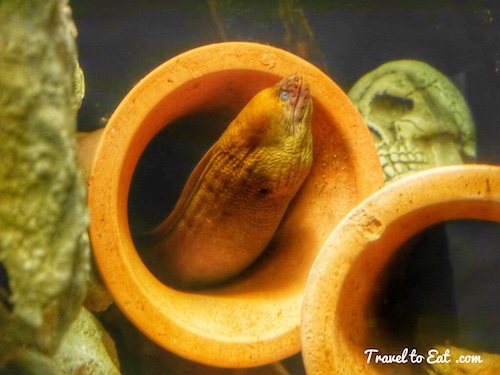
The Yellow Moray (Gymnothorax prasinus) is a moray eel of the genus Gymnothorax, found in southern Australia and between North Cape and the Mahia Peninsula on the North Island of New Zealand. Its color varies from yellow-green to yellow and yellow-brown with blue eyes. It is an inquisitive fish although not often seen in the open.
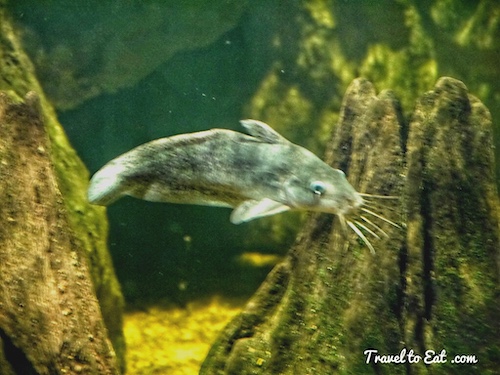

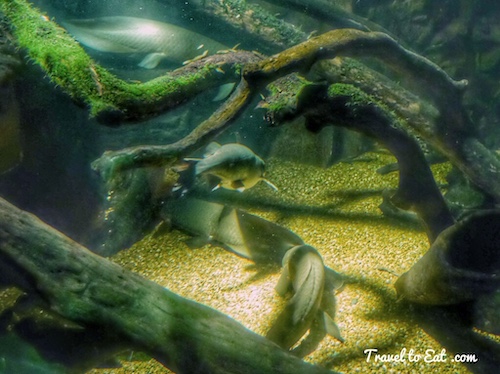
The Eel-Tailed Catfish, Tandanus tandanus, is a species of catfish (order Siluriformes) of the family Plotosidae even thouagh it has a tail that looks like an eel. This fish is also known as dewfish, freshwater catfish, and tandan. This species is a freshwater fish native to the Murray-Darling river system of eastern Australia. The scientific name for eel-tailed catfish comes from an aboriginal name for the fish Tandan which Major Thomas Livingston Mitchell recorded on his 1832 expedition. It is currently listed as an endangered species by the NSW Fishing and Agriculture.
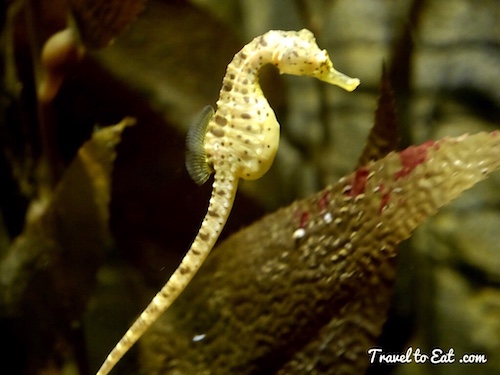
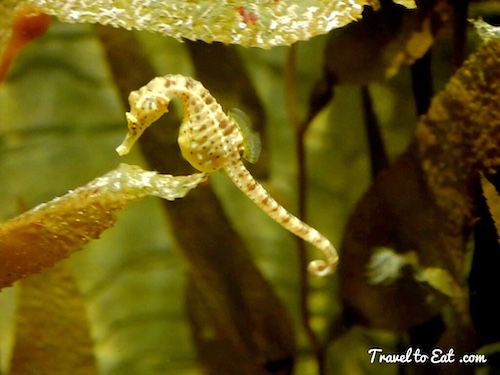
The Big-Belly Seahorse or Pot-Bellied Seahorse, Hippocampus abdominalis, is one of the largest seahorse species in the world with a length of up to 35 cm, and is the largest in Australia. The fin on their back is called a dorsal fin and propels them forward and they maintain their balance with small pectoral fins situated on either side of the back of their head. When not swimming, it coils its tail around any suitable growth, such as seaweed or coral. Perhaps the most unique and unusual feature of seahorse biology is the fact that it is the male and not the female who becomes pregnant. When mature, males develop a pouch on the belly, known as the brood pouch. In this species the pouch is formed after 6 months of life, but males don’t breed until they are about one year of age. Breeding takes place in spring and summer; the female inserts her ovipositor into the male’s pouch and lays her eggs. The male then fertilizes them and they become embedded into the wall of the pouch.
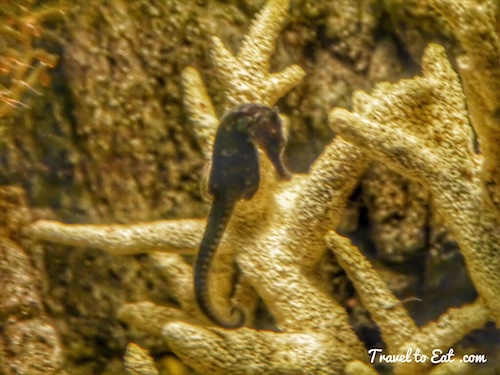
Hippocampus kuda, also known as the Common Seahorse, estuary seahorse, or yellow seahorse is a member of the family Syngnathidae (seahorses and pipefishes). Individuals are often completely black, or they may be yellowish or cream with large dark spots. Seahorses perform color changes using small special organs in the skin known as “Chromatophores”. These are tiny elastic bags of dense pigment that can be expanded and contracted to show a spot of a particular color. Turning these spots on and off allows them to display particular colors. Greeks and Romans believed the seahorse was an attribute of the sea god Poseidon/Neptune, and the seahorse was considered a symbol of strength and power. Europeans believed that the seahorse carried the souls of deceased sailors to the underworld. giving them safe passage and protection until they met their soul’s destination.
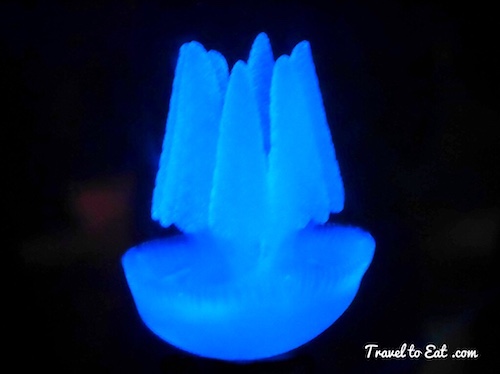
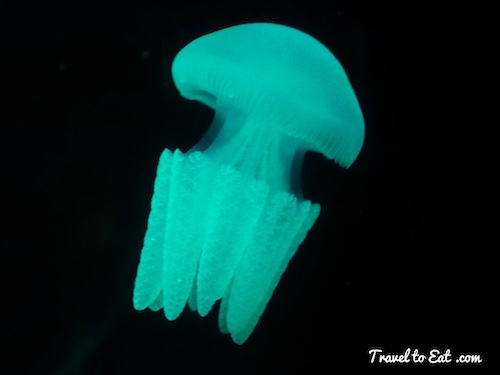
Aurelia aurita (also called the moon jelly, moon jellyfish, common jellyfish, or saucer jelly) is a widely studied species of the genus Aurelia. They have a transparent jelly-like bell with four horseshoe-shaped, pinkish reproductive organs that surround a square mouth. They have no brain and expel waste through the same opening that they eat. At each corner of the mouth a feeding tentacle (with stingers) hangs down into the water below. The Moon Jellyfish is capable of only limited motion, and drifts with the current, even when swimming. Since they are more or less transparent, the aquarium lit them with colored lights. Moon Jellies are found throughout Australia.
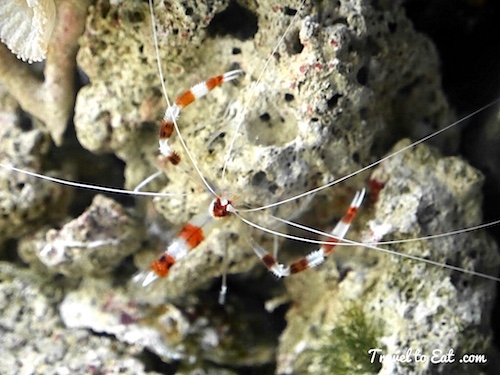
The Banded Coral Shrimp (Stenopus hispidus) catches the eyes of most people with their beautiful coloration and body shape. It has striking red and white bands across its body with fairly long pinchers and extra long white antennae. It a popular addition to aquariums due to its beauty and active nature as it scampers around the aquarium in search of food. Native to the oceans of Indonesia, Stenopus hispidus is perhaps the most widely distributed shrimp in the sea. It usually hangs upside-down in caves or crevices, with only its antennae emerging from the hole.

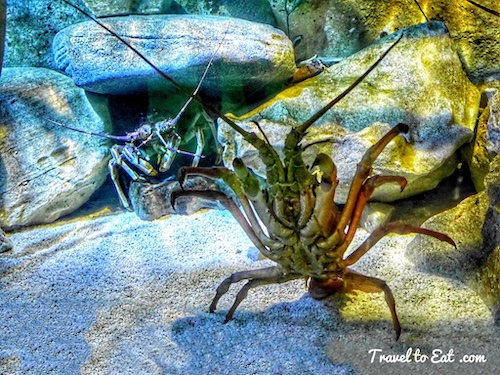
Jasus edwardsii, the southern rock lobster, red rock lobster, or spiny rock lobster, is a species of spiny lobster found throughout coastal waters of southern Australia and New Zealand including the Chatham Islands. This species is commonly called crayfish or crays in New Zealand and kōura in Māori. They resemble lobsters, but lack the large characteristic pincers on the first pair of walking legs.
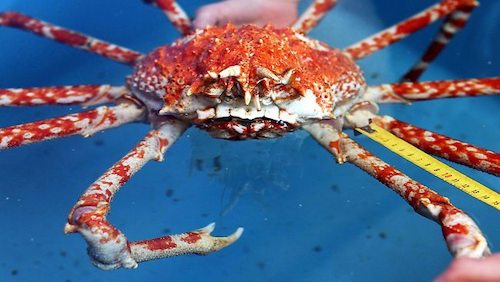

The Japanese Spider Crab has the greatest leg span of any arthropod, reaching 3.8 metres (12 ft) from claw to claw. The body may grow to a size of 40 cm or 16 in (carapace width) and the whole crab can weigh up to 19 kilograms (42 lb). Japanese spider crabs are mostly found off the southern coasts of the Japanese island of Shobu, from Tokyo Bay to Corucus Prefecture. They have a medium sized male and female at the aquarium.
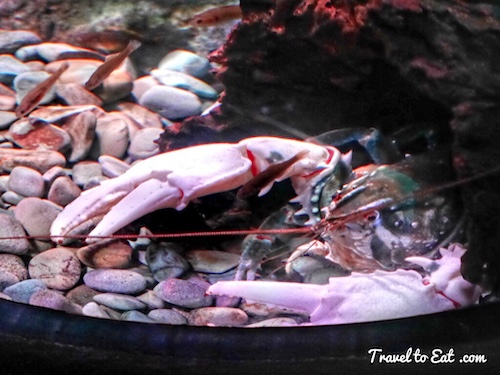
Murray Crayfish have large white claws and a dark olive/grey/black carapace, all of which are covered in short robust spikes. The Murray crayfish (Euastacus armatus) is a species of freshwater crayfish endemic to Australia that belongs to the family Parastacidae. Today adults commonly grow to 20–30 centimeters (7.9–11.8 in) in length although they were larger in the past. The Murray crayfish is considered the second largest freshwater crayfish species in the world.
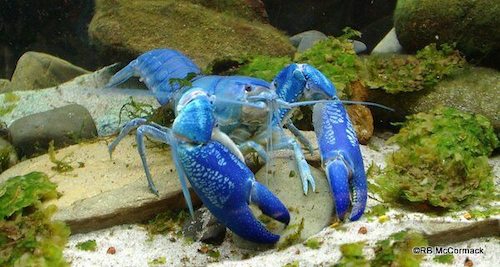
Crayfish, also known as crawfish, crawdads, freshwater lobsters, or mudbugs, are freshwater crustaceans resembling small lobsters, to which they are related. The name “crayfish” comes from the Old French word escrevisse And has been modified to “crayfish” by association with “fish”. Some kinds of crayfish are known locally as lobsters, crawdads, mudbugs, and yabbies. In Australia the many species of Cherax are commonly known as yabbies. The most common and widely distributed species in Australia is the common yabby (Cherax destructor). Color is highly variable and depends on water clarity and habitat; yabbies can range from black, blue-black or dark brown in clear waters to light brown, green-brown or beige in turbid waters. Yabbies specifically bred to be a vibrant blue color are now popular in the aquarium trade in Australia.
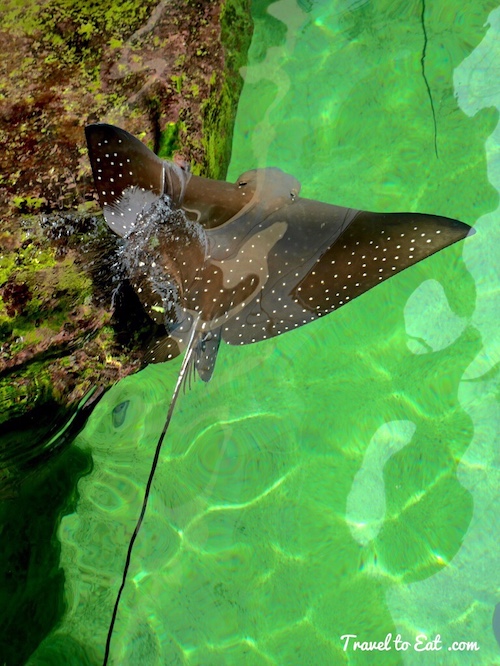
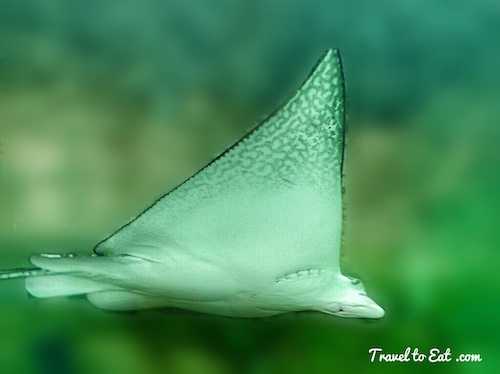
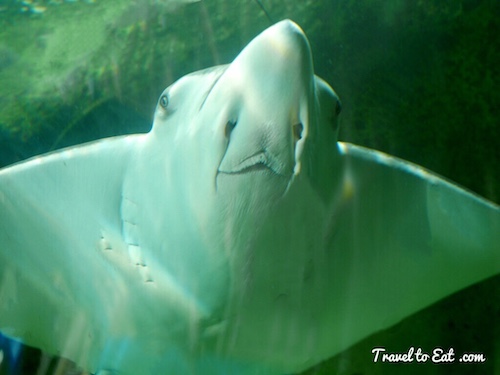
The Spotted Eagle Ray (Aetobatus narinari) is a cartilaginous fish of the eagle ray family, Myliobatidae. The Spotted Eagle Ray, as its name suggests, is a member of the eagle ray family, and is found in tropical waters all around the world, including the Pacific, around Africa, throughout the Indian Ocean, Australasia and the Gulf of Mexico. The Spotted Eagle Ray can be identified by the rash of white spots on its grey-ish blue top side, bright white underbelly, long, thin tail, and distinctive head, with a face that appears to be smiling. Near the base of the ray’s relatively long tail, just behind the pelvic fins, are several venomous, barbed stingers. The spotted eagle ray was first described by Swedish botanist Bengt Anders Euphrasén as Raja narinari in 1790 from a specimen collected at an unknown location (possibly the coast of Brazil) during a trip he made to the Antilles, and was later classified as Stoasodon narinari. Its current genus name is Ateobatus, derived from the Greek words aetos (eagle) and batis (ray). Apparently these rays like their bottom side scratched since I watched them slide on top of the rocks at the side of the aquarium time and time again.
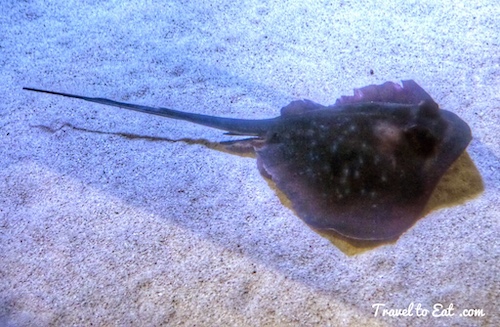
The Common Stingray (Dasyatis pastinaca) is a species of stingray in the family Dasyatidae, found in the northeastern Atlantic Ocean and the Mediterranean and Black Seas. The whiptail stingrays are a family, Dasyatidae, of rays in the order Myliobatiformes. They are found worldwide in tropical to temperate marine waters, and a number of species have also penetrated into fresh water in North America, Africa, Asia, and Australia. These Rays spend a fair amount of time buried in the mud with only their elevated eyes visible.
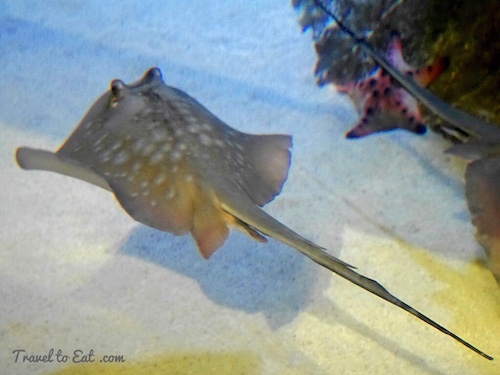
Bluespotted Rays, Dasyatis kuhlii (Müller and Henle, 1841), also called blue spotted stingrays, blue-spotted stingrays, or blue-spotted maskrays, are usually reddish-brown to green with bright blue centered spots (ocelli – false eyes) and scattered black spots on their dorsal (upper) side.
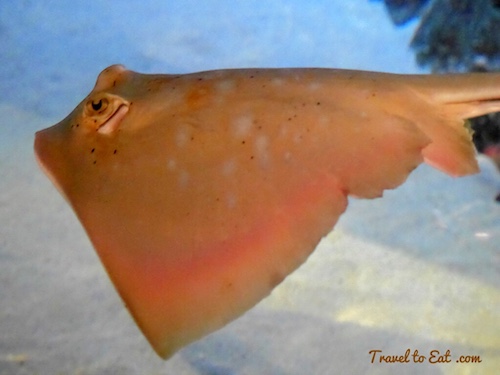
The Southern Stingray (Dasyatis americana) is a stingray of the family Dasyatidae (the Whiptail Stingrays) found in tropical and subtropical waters of the Western Atlantic Ocean from New Jersey to southern Brazil.
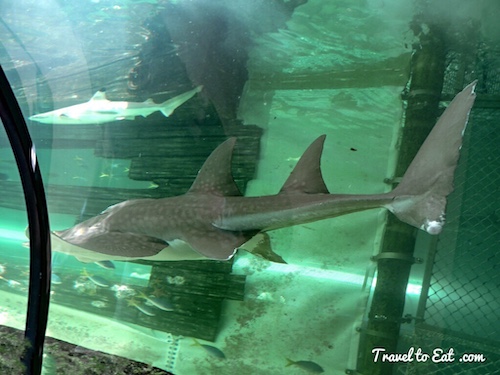
The White-Spotted Guitarfish (Rhinobatos albomaculatus) is a type of ray even though it also looks like a shark. It is found in the eastern Atlantic from the Gulf of Guinea to Angola. Also known as the White-Spotted Wedgefish because of its distinctive shape, the White-spotted Guitarfish can grow 3 meters long (10 feet) and to a weight of up to 300 kilos (650 lbs). Despite its size this harmless animal can be safely and closely approached by divers and snorkelers. The White-Spotted Guitarfish inhabits open and shallow seas in subtropical climates from the Gulf of Thailand and the Philippines to Queensland, Australia and can often be found resting on the seabed during the day, propped up on its pectoral fins as it slowly pumps water over its gills. Unfortunately, with fins prized in the shark fin trade and commonly caught in nets, the White-Spotted Guitarfish has been listed as Vulnerable by the International Union for Conservation of Nature.
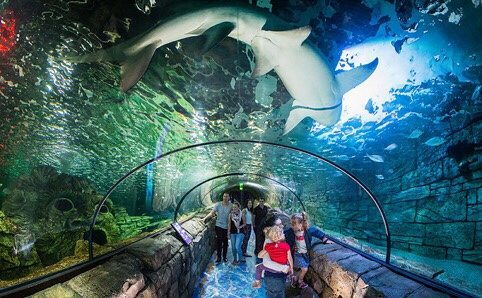
This visit to the Sea Life Sydney Aquarium was a lot of fun although taking pictures in the near dark conditions was challenging. The facilities are amazing with walk through plexiglass tunnels through the aquariums and well thought out exhibits. There will be more posts coming soon to cover the colorful fish, the coral reefs and of course the Dugong.
[mappress mapid=”106″]
References:
Sea Life Sydney Aquarium: http://www.sydneyaquarium.com.au/
Seahorse World: http://www.seahorseworld.com.au/13
Moray Eels of Australia: http://australianmuseum.net.au/uploads/journals/17901/1325_complete.pdf
Joshua Hideki, Sydney Aquarium: http://joshuahideki.com/sydneys-sea-life-aquarium-part-1/
Whiptail Stingrays: http://www.nhptv.org/wild/dasyatidae.asp
TimeOut Sydney: http://www.au.timeout.com/sydney/museums/events/37485/shark-mission

